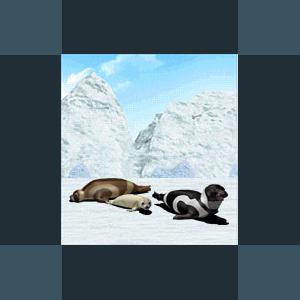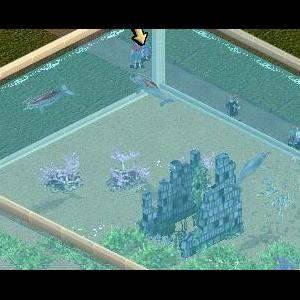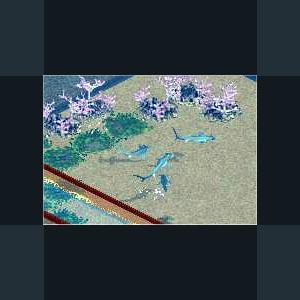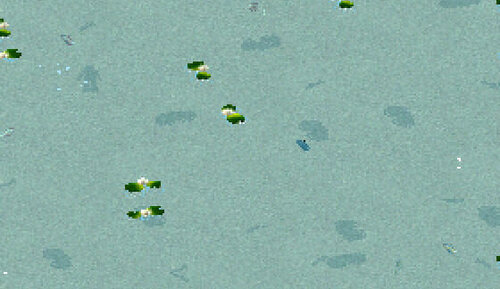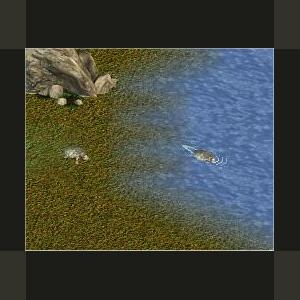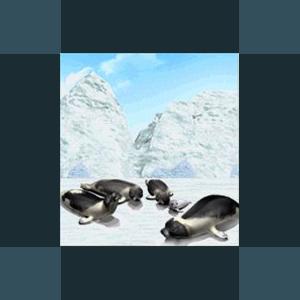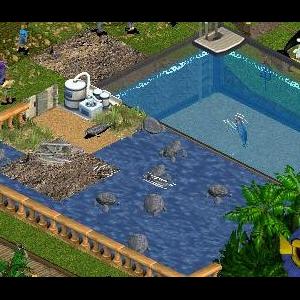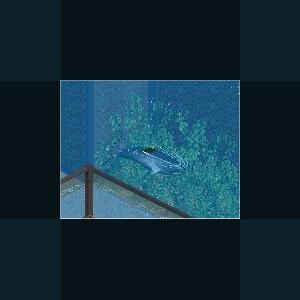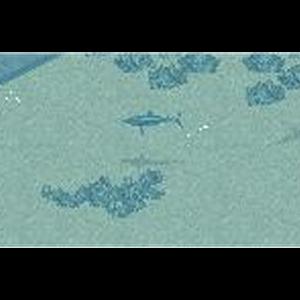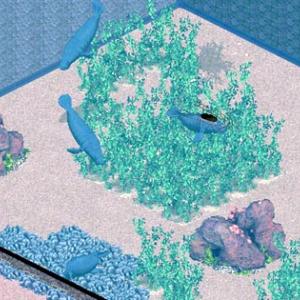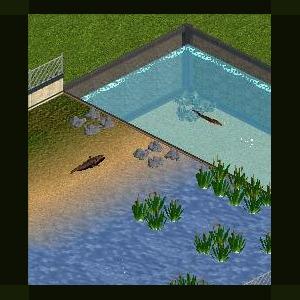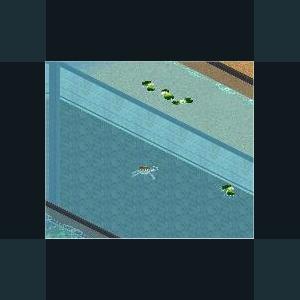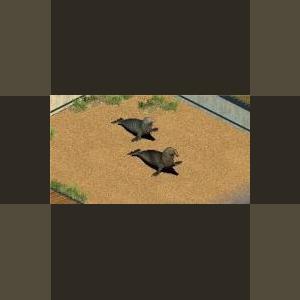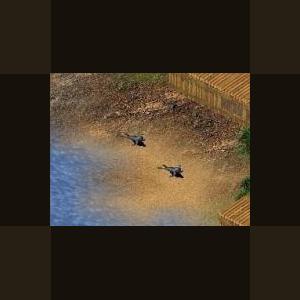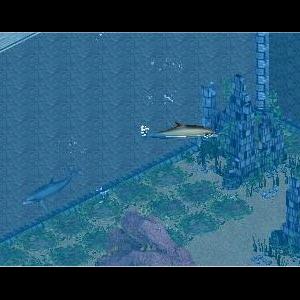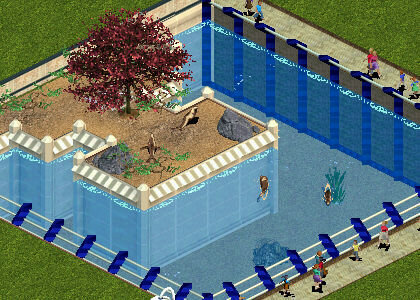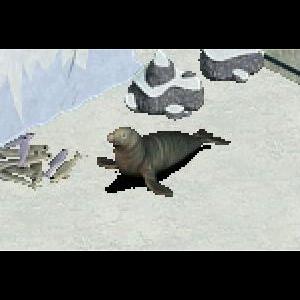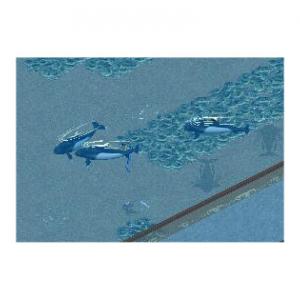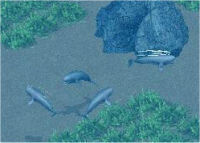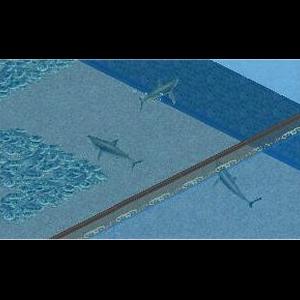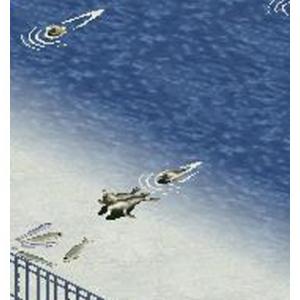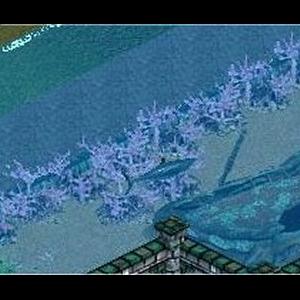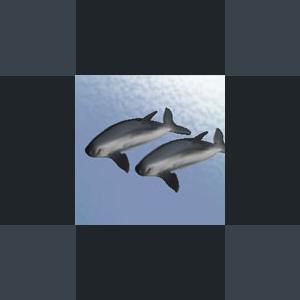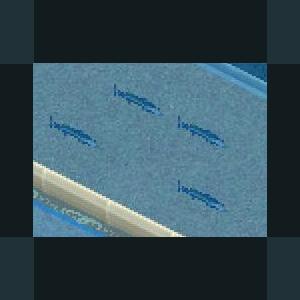Marine
Creatures under the sea
47 files
-
Ribbon Seal by Tasmanian Tiger
By Guest
The ribbon seal of the north pole to add to your zoo!
The ribbon seal is compatible with the emperor penguin, although the emperor penguin doesn't like it, it will accept its presence and cause no problems.
Updated: September 27, 2013 by Jay to remove the background for the male animal list icon, to add animal list icons for the female and young, to remove the top and bottom edges of the purchase menu icons, to adjust the positions of all animations, to make minor adjustments to the animal info, to add the preferred object tooltip for the female and young, to add the capability of a simple surface roll trick for show tanks, to add the capability to use 3 user made toys, to add a purchase menu tooltip, to remove unnecessary files and configuration lines, and to correct configuration mistakes done by the APE program. Please note that the version at Taz's site is no longer the most current version, since she is deceased.
Current ztd date: September 27, 2013
Compatibility : All Game Versions
Description : The ribbon seal or the Histriophoca fasciata grows to a maximum of 1.9 metres in size. It is found in the Arctic and Subarctic regions of the North Pacific Ocean, notably in the Bering Sea and Sea of Okhotsk. It is the only species in the genus Histriophoca. The Ribbon Seal is a medium-sized pinniped from the family called Phocidae. Members of the Phocidae family are also called true seals or earless seals because they lack external ear flaps. Since newborn ribbon seals do not enter the water for a number of weeks, the young of this ribbon seal does not go in water. This Ribbon Seal can use the Ice Floe For Certain Animals By Taz, the Ice Floe For Certain Animals, and the Raft For Certain Animals. The Ribbon Seal is compatible with the Emperor Penguin, although the Emperor Penguin doesn't like it but will accept its presence and cause no problems. However, if the Emperor Penguin is in the same exhibit, then the exhibit must not have the Ice Floe For Certain Animals By Taz, the Ice Floe For Certain Animals, or the Raft For Certain Animals, since the penguin could get stuck on those toys, being that the penguin is not configured for those toys. The Ribbon Seal is also compatible with the Harp Seal made by Taz.
Note: ZT is not used to animals where the adults go in tanks while the young do not. So it can keep changing its mind between the exhibit being suitable and the exhibit needing more salt water terrain and less snow. Whenever it does change its mind and wants more salt water terrain, do so. Eventually it will get to a point where it does not change its mind.
1,204 downloads
Updated
-
Baiji by Tasmanian_tiger
By Tasmanian_tiger
The baiji is a freshwater dolphin found only in the Yangtze River in China. The dolphin is also called Chinese River Dolphin, Yangtze River Dolphin, Whitefin Dolphin and Yangtze Dolphin. The Baiji population declined drastically in decades as China industrialized and made heavy use of the river for fishing, transportation, and hydroelectricity. Efforts were made to conserve the species, but a late 2006 expedition failed to find any Baiji in the river. Organizers declared the Baiji "functionally extinct",[4] which would make it the first aquatic mammal species to become extinct since the demise of the Japanese Sea Lion and the Caribbean Monk Seal in the 1950s.
I hope you enjoy this addition to your zoos. Combine the baiji with pandas to create lively 'river-tanks'.
Updated: July 10, 2013 by Jay to correct 3 animation views, to remove unnecessary files and configuration lines, and to make some minor adjustments to the animal info.
The update dated Jul 28 2013 is not an update. It is because I moved the file from Animals to Marine.
839 downloads
Updated
-
Bonnethead Shark by Ghirin
By Guest
The bonnethead shark (Sphyrna tiburo) is one of the the smallest members of the hammerhead shark family. These small sharks prefer tropical and subtropical coastal regions where there is continental shelf and are exclusive to the western hemisphere. Bonnethead sharks migrate to warmer waters during the winter months.
Bonnethead sharks are easy to distinguish from other hammerheads by the shape of their heads, which is more shovel-shaped than other hammerhead species. Their diet consists of crustaceans such as blue crabs and shrimp, mollusks, and small fishes. Females tend to consume more food, possibly to provide energy for reproduction.
This species of shark usually forms schools of up to fifteen individuals and they use their cerebrospinal fluid for communication between individuals. During birthing season (these sharks are livebearers), females predominate in shallow waters.
*Inspired by the Zoo Tycoon Brains Trust at the Zoo Tek Forums.
References:
-Hessing, S. 2000. "Sphyrna tiburo" (On-line), Animal Diversity Web. http://animaldiversi...rna_tiburo.html.
-Bester, C. "Bonnethead" (On-line), Florida Museum of Natural History.
http://www.flmnh.ufl...Bonnethead.html
Created by Ghirin 2004
699 downloads
Updated
-
Trout Pack by Coolperson5
By Guest
A pack of freshwater trout.
This pack includes 5 species of freshwater trout.
Apache Trout
Bull Trout
Cutthroat Trout
Gila Trout
Golden Trout
Each fish needs a 5 square tank of any depth with 2 squares of water lilys and one square of rocks. The zookeeper will say that it needs a mate if it is alone, but it will not affect suitability or happiness.
Have Fun!
This file includes both Trout Pack_CP5Combined.ZTD, which is combined, and the 5 individual files. If the combined .ZTD is used, the others are not needed.
580 downloads
0 comments
Updated
-
Western Pond Turtle by Ghirin
By Guest
Western Pond Turtle
Author: Ghirin
The western pond turtle is native to the Pacific Northwest of North America. Its preferred habitat is near streams, rivers and slow-moving bodies of water. The diet includes insects, small fish, and frogs.
Created by Ghirin 2005
548 downloads
Updated
-
Harp Seal by Tasmanian_tiger
By Fern
Author : Taz (Tasmanian_tiger)
Category : Real animal, Pinniped
Updated: September 25, 2013 by Jay to remove the background for the male and female animal list icons, to add an animal list icon for the young, to remove the top and bottom edges of the purchase menu icons, to adjust the positions of all animations, to make minor adjustments to the animal info, to add the preferred object tooltip for the female and young, to add the capability of a simple surface roll trick for show tanks, to add the capability to use 3 user made toys, to remove unnecessary files and configuration lines, and to correct configuration mistakes done by the APE program.
Current ztd date: September 25, 2013
Compatibility : All Game Versions
Description : The Harp Seal is somewhat larger than the Common Seal, growing to 5.5 ft (1.67 m) long and with a weight of 115-180 kg (253-400 lb). Males are distinctly larger than females. Harp Seals are well known for the saddle-like spot on their backs. Adult males are creamy white overall, with a dark chocolate brown head and a broad dark chocolate brown U-shaped pattern on their back, running across the shoulders and down each flank to near the base of the tail; the pattern is often slightly asymmetrical and irregular, with dark brown spots extending onto the white parts. Adult females have a similar but less distinct pattern, with the brown being paler and greyer. Immature Harp Seals up to two to three years old are pale grey, variably spotted with darker grey. The flippers are white or pale grey, with five stout claws on each fore flipper. The tail is short, 10-15 cm long. The fur on adults is 2 cm long, dense, stiff, and velvety; the skin is roughly the same color as the fur: whitish-grey under the white fur, and dark brown under the brown fur. The vibrissae are numerous on the muzzle, the longest about 12 cm long. The newborn pups are all white except for a black nose and eyes, which helps them blend in with the snow. Puberty is reached at 5-7 years, and the maximum lifespan is more than 30 years. Since newborn harp seals do not enter the water for a number of weeks, the young of this harp seal does not go in water. This Harp Seal can use the Ice Floe For Certain Animals By Taz, the Ice Floe For Certain Animals, and the Raft For Certain Animals. The Harp Seal is compatible with the Emperor Penguin, although the Emperor Penguin doesn't like it but will accept its presence and cause no problems. However, if the Emperor Penguin is in the same exhibit, then the exhibit must not have the Ice Floe For Certain Animals By Taz, the Ice Floe For Certain Animals, or the Raft For Certain Animals, since the penguin could get stuck on those toys, being that the penguin is not configured for those toys. The Harp Seal is also compatible with the Ribbon Seal made by Taz.
Note: ZT is not used to animals where the adults go in tanks while the young do not. So it can keep changing its mind between the exhibit being suitable and the exhibit needing more salt water terrain and less snow. Whenever it does change its mind and wants more salt water terrain, do so. Eventually it will get to a point where it does not change its mind.
515 downloads
0 comments
Submitted
-
Habour (or Common) Seal by Tasmanian Tiger
By Fern
Harbour (or Common) Seal
Author : Taz (Tasmanian_tiger)
Category : Real animal, Pinniped
Updated: June 29, 2013 by Jay to correct 3 animation views, to remove unnecessary files and configuration lines, and to correct configuration mistakes done by the APE program, primarily related to animal behaviors and to sounds. Please note that the version at Taz's site is no longer the most current version, since she is deceased.
Current ztd date: June 29, 2013
Compatibility : All Game Versions
Description : The most widespread pinniped, the Common or Harbour Seal has a plump body and a small, cat-like head with a slight forehead and nostrils that form a V-shaped pattern. Its coat ranges from light to dark grey or brown, and has spots, rings and blotches all over. The breeding season varies regionally, and the pups are able to crawl and swim almost within an hour of birth. There are at least five subspecies of Common Seal. One of them, the Ungava Seal, lives in fresh water in N. Quebec, Canada. (Text by Dorling Kindersley Handbooks.)
478 downloads
0 comments
Updated
-
Shortfinned Pilot Whale by Ghirin
By Guest
Short-finned Pilot Whale by Ghirin
The short-finned pilot whale (Globicephala macrorhynchus) is a large member of the dolphin family.
It is extremely social and usually travels in large groups.
References:
http://www.acsonline.org/factpack/PilotWhale.htm
www.wikipedia.org
*Inspired by the Zoo Tycoon Brains Trust at the Zoo Tek Forums*
477 downloads
0 comments
Updated
-
Fresh Water Bull Shark by Ghirin
By Guest
The bull shark (Carcharhinus leucas) is a large, robust shark found in shallow coastal marine waters worldwide. These sharks will also enter and live in estuaries, freshwater lakes and rivers.
Bull sharks eat both bony fishes and small sharks. In the cooler portions of their range, bull sharks mate during the summer months; however, in the warmer parts of their range they may breed year-round. Females nourish the young internally for 10 to 11 months and give birth to free-swimming pups.
*Inspired by the Zoo Tycoon Brains Trust at the Zoo Tek Forums.
Reference:
http://www.flmnh.ufl.edu/fish/Gallery/Descript/bullshark/bullshark.htm
Created by Ghirin 2004
476 downloads
0 comments
Updated
-
West African Manatee by BigCatKeeper
By Guest
West African Manatee Author: BigCatKeeper
http://www.zoo-tek.com/forums/index.php?download=167
Manatees are large, cylindrically shaped mammals, with forelimbs modified in to flippers, no free hind limbs, and the rear of the body in the form of a flat, rounded, horizontal paddle. The flexible flippers are used for aiding motion over the bottom, scratching, touching and even embracing other manatees, and moving food into and cleaning the mouth. Its upper lip is modified into a large bristly surface, which is deeply divided. It can move each side of the lips independently while feeding. The general coloration is grey.
The West African manatee weighs less than 500 kg (1100 lb). Adults are generally 3 - 4 m (10 - 13') long. It inhabits coastal areas, estuarine lagoons, large rivers that range from brackish to fresh water, freshwater lakes and the extreme upper reaches of rivers above cataracts. This manatee species is dependent on emergent or overhanging, rather than submerged, vegetation. Populations in some rivers depend heavily on overhanging bank growth, and those in estuarine areas feed exclusively on mangroves. Seasonal movements in response to changes in water level affecting availability of food and/or water salinity have been reported in several areas. An individual manatee may travel 30 - 40 km/day (19 - 25 mi/day) through lagoons and rivers.
The West African manatee occurs from Senegal to Angola; its numbers continue to decrease. The population decline has been attributed largely to hunting and incidental capture in fishing nets. Despite legal protection, the manatee is still hunted throughout its range. It is sometimes also killed in turbines or control gates of dams. The coastal wetlands that are a major habitat for the manatee have already been heavily damaged and are further severely threatened. Woodcutting is resulting in the extermination of mangrove stands in some areas. Mangrove clearance, as well as erosion due to forest clearance upstream, are resulting in increased sedimentation that silts up lagoons and estuaries.
West African Manatee created by Bigcatkeeper
Many thanks to Professorpaul
464 downloads
0 comments
Updated
-
0 comments
Submitted
-
Pig-Nosed Turtle by Ghirin
By Guest
The pig-nosed turtle (Carettochelys insculpta), also known as the Fly River turtle, is a unique species of freshwater turtle native to northern Australia and southern New Guinea. The turtle gets its name from the way its nostrils are located in the front of its snout.
Even though the pig-nosed turtle is a freshwater turtle, it resembles a sea-going turtle because it has flippers instead of front legs. These turtles have been found in a variety of habitats, including rivers, estuaries, lagoons, lakes, swamps and water pools. The waterway bottoms are usually covered with gravel and the banks are usually heavily forested.
Pig-nosed turtles are omnivorous, but have a preference for fruit and leaves.
References:
http://www.tortoise.org/archives/pignose.html
http://www.whozoo.org/Intro2002/RacheLoftin/RNL_flyriverturtle.html
http://www.chelonia.org/carettochelys_gallery.htm
Created Ghirin 2005
452 downloads
0 comments
Updated
-
Southern Elephant Seal by Ghirin
By Guest
The southern elephant seal (Mirounga leonina) is the largest living species of pinniped. This large seal is native to the sub-antarctic region.Elephant seals feed on fish and squid. They are know for their long, deep dives in search of prey.
447 downloads
0 comments
Updated
-
Caspian Seal by Ghirin
By Guest
The Caspian seal (Pusa caspica) is one of the smallest true seals in the world. It is native to the brackish waters of the Caspian Sea.
The Caspian seal is thought to be derived from the ringed seal of the Arctic and is close relative of the Siberian nerpa.
References:
http://en.wikipedia.org/wiki/Caspian_Seal
http://www.caspianenvironment.org/biodb/eng/mammals/Phoca%20(Pusa)%20caspica/main.htm
Created by Ghirin 2008
445 downloads
0 comments
Updated
-
Spinner Dolphin by LAwebTek
By Guest
Spinner Dolphin
Author: LAwebTek
Classified Stenella longirostris in 1828 - the specific name referring to this species' long snout. This species is found in tropical and subtropical waters worldwide. There are no subspecies, but there are four distinct Eastern Pacific forms: the Eastern, the Whitebelly, the Costa Rican and the Hawaiian.
The Spinner Dolphin is a slender creature with a long, thin beak to which the distinct forehead slopes gently. The dorsal varies with both age and geographical form; it can lean forward, be curved, or be completely triangular in shape. The flippers are long and pointed, and a stripe links them to the eyes. Eastern Pacific and Costa Rican animals are mainly grey, with other forms usually two- or three-tone. Both the Hawaiian and Whitebelly forms have a dark grey or black dorsal cape, paler flanks and sides, and a creamy-white belly. All forms measure between 1.3 and 2.1m in length, and weigh between 45-75kg.
Units range from a few animals to a few thousand, often mixing with other cetacean species such as Pilot Whales and Spotted Dolphins. They are dramatically acrobatic, with somersaults, high spinning leaps and other aerial movements popular. They vocalise with whistles and clicks, and can travel as fast as 20kph. Spinner Dolphins inhabit both offshore and inshore waters and feed on midwater fish and squid. They are different from other dolphins in that they feeds at night.
Spinner Dolphins are often targeted in the purse-seine and yellowfin tuna fisheries of the eastern Pacific Ocean. Elsewhere, many of these dolphins are accidentally killed in gillnets, and also taken in harpoon fisheries. Some individuals have been kept successfully in captivity for at least 10 years.
2003 LAwebTek
427 downloads
Updated
-
Japanese Sea Lion by Coolperson5
By Guest
Japanese Sea Lion (Zalophus japonicus) is thought to have become extinct in the 1950s.
Prior to 2003 it was considered to be a subspecies of California Sea Lion as Zalophus californianus japonicus. However, it was subsequently reclassified as a separate species. Some taxonomists still consider it as a subspecies of the California Sea Lion. It has been argued that japonicus, californianus, and wollenbaeki are distinct species because of their distant habitation areas and behavioral differences.
They inhabited the Sea of Japan, especially around the coastal areas of the Japanese Archipelago and the Korean Peninsula. They generally bred on sandy beaches which were open and flat, but sometimes in rocky areas.
Currently, several stuffed specimens can be found in Japan and the National Museum of Natural History, Leiden, the Netherlands brought by Philipp Franz von Siebold. The British Museum possesses a pelt and 4 skull specimens.
426 downloads
0 comments
Updated
-
Crabeater Seal by Ghirin
By Guest
Crabeater Seal by Ghirin
The crabeater seal (Lobodon carcinophagus) is one of the most common large mammals in Antartica.
It is known for its complicated tooth pattern which forms an interlocking sieve for filtering krill.
Crabeater seals usually haul out on the pack ice, but have also been known to travel inland.
*Inspired by Professor Paul's Nature Encyclopedia at the Zoo Tek Forums*
References:
http://en.wikipedia.org/wiki/Crabeater_Seal
http://www.antarcticconnection.com/antarct...crabeater.shtml
422 downloads
0 comments
Updated
-
Commersons Dolphin by Ghirin
By Guest
Commerson’s dolphin (Cephalorhynchus commersonii), also known as the piebald dolphin, is native to coastal waters of the southwestern Atlantic Ocean. (A second population has been identified in the Indian Ocean.) This dolphin is easy to recognize due to its striking black and white skin pattern. Young are born grey and become two-toned with age.
Commerson’s dolphins prefer coastal waters where the continental shelf is wide and flat. Their diet consists of squid, crustaceans, and fish. They usually travel in small groups of two to four animals, but large schools have been reported.
*Inspired by the Zoo Tycoon Brains Trust at the Zoo Tek Forums.
References:
Walker’s Mammals of the World. Nowak, 1999.
Animal: The Definitive Visual Guide the World’s Wildlife. Burnie and Wilson, 2001.
http://www.bbc.co.uk/nature/wildfacts/factfiles/79.shtml
Created by Ghirin 2004
413 downloads
0 comments
Updated
-
Finless Porpoise by Ghirin
By Guest
Finless Porpoise Author: Ghirin
The finless porpoise (Neophocaena phocaenoides) is found in the costal waters from the Persian Gulf to Japan. Populations are also found in adjacent estuaries, rivers, and shallow channels. They prefer shallow waters (up to 50 m deep) with soft or sandy bottoms.
Due to its lack of a dorsal fine, it is easy to identify in the wild. The living animal is often blue-gray and may darken after death. The neck vertebrae are not fused, allowing the animal to turn its head. Males may grow to 2 m and females range up to 1.5 m in length.
Finless porpoises often seen in singly or in groups of 2-4. Large groupings of up to 20 have been reported. Their primary diet consists of small fish, squid, crustaceans, and octopus.
Created by Ghirin 2003
413 downloads
0 comments
Updated
-
Hawaiian Monk Seal by Ghirin
By Guest
Hawaiian monk seals (Monochus schauinslandi) are found in the outer islands of the Hawaiian chain. Their genus, Monachus, is the only seal genus found in the tropics.
412 downloads
0 comments
Updated
-
Bronze Whale by Ghirin
By Guest
The bronze whaler (Carcharhinus brachyurus) is found in open seas as well as coastal areas and reefs. It is thought to feed on fish, small sharks and cephalopods.
Female bronze whalers give birth to 13-20 live young which can then live independently.
*Inspired by the Zoo Tycoon Brains Trust at the Zoo Tek Forums.
Reference:
Sharks, Ferrari and Ferrari. 2002.
Ghirin 2005
400 downloads
0 comments
Updated
-
Harp Seal by Ghirin
By Guest
The harp seal (Phoco groenlandica) is native to the north Atlantic ocean, ranging from the Gulf of St. Lawrence to Greenland. The fur of the seals changes with the age of the seal. The coat of the pup is white, turning gray after a few weeks. The adult coat has a background color of silvery gray with dark markings on the head and a dark band running up each flank and over the back that resembles a horseshoe or a harp.
The harp seal spends most of its time in the open sea or on ice. In the spring, the harp seals haul out on the sea ice for moulting, birthing pups, and breeding. Large numbers of seals may come together during this time.
Harp seals feed on fish and crustacenas. They bite breathing holes into the ice so that they have access to fresh air between dives for food.
References:
http://www.pagophilus.org/harpseals.htm
http://www.bbc.co.uk/nature/wildfacts/factfiles/166.shtml
Walker's mammals of the World, Nowak, 1999
Photograph:
http://www.pagophilus.org/birth.htm
Created by Ghirin 2003
394 downloads
0 comments
Updated
-
Galapogos Shark by Ghirin
By Guest
The Galapagos shark (Carcharhinus galapagensis) is a common resident in the coastal waters of many tropical islands. This shark prefers shallow waters but has been known to swim in the deep water between islands. They are usually found near coral reefs.
Galapagos sharks feed on bottom-dwelling fishes such as flatfish and triggerfish. It is a viviparous species with litter sizes ranging from 6 to 16 pups. The young sharks form “nurseries” in shallow water to avoid predation by larger sharks.
This shark is known for its display when it feels threatened. The back is arched, the head is raised, and the pectoral and tail fins are lowered. The shark then swims in a twisting, rolling motion.
*Inspired by the Zoo Tycoon Brains Trust at the Zoo Tek Forums.
References:
http://www.shark.ch/cgi-bin/Sharks/spec_conv.pl?E+Carcharhinus.galapagensis
http://www.flmnh.ufl.edu/fish/Gallery/Descript/GalapagosShark/Galapagosshark.html
Created by Ghirin 2004
393 downloads
0 comments
Updated
-
Vaquita (or Gulf of California Porpoise) by Tasmanian Tiger
By Fern
Vaquita (or Gulf of California Porpoise)
Author : Taz (Tasmanian_tiger)
Category : Tank animal, Critically endangered animal, Cetacean
Updated: July 26, 2013 by Jay to remove unnecessary files and configuration lines and to make some minor adjustments to the animal info.
Current ztd date: July 26, 2013
Compatibility : MM/CC
Description : The vaquita, or also called the 'Gulf of California Porpoise', is one of the smallest cetaceans around. It's about 1.5 meters or 5 feet long. Please note that the version at Taz's site is no longer the most current version, since she is deceased.
390 downloads
0 comments
Updated
-
Pacific Baracuda by BigCatKeeper
By Guest
Pacific Barracuda Author: BigCatKeeper
The Pacific barracuda is slim-bodied, has a tapered head, a long thin snout, and large canine teeth in a lower jaw that projects beyond the upper. It also has a forked tail, large eyes, and short, widely separated dorsal fins with 5 dorsal spines and 10 dorsal rays. The anal fins have 2 spines followed usually by 9 rays. Greyish-black on the back with a blue tinge, shading to silvery white on the sides and belly, it has a yellowish tail which lacks the black blotches on the sides of the body that are characteristic of other barracudas. Large females have a charcoal black edge on the pelvic and anal fins, whereas the male fins are edged in yellow or olive.
The Pacific barracuda is shorter than the great barracuda. It reportedly can grow up to 5 feet but has only been recorded to 4 feet; it rarely weighs more than 10 pounds, and though fish of about 12 pounds have been captured, most of the fish caught by anglers are much smaller. They grow to at least 11 years old, and the females grow larger than the males, with most fish over 8 pounds and all fish over 11 pounds being female. The growth rate is similar in both sexes until the fourth year of life, when the females begin to grow a bit faster. Pacific barracudas occur along the Pacific coast of North America from Alaska to Magdalena Bay, Baja California, though their common range is between Point Conception, California, and Magdalena Bay. The Pacific barracuda is the only barracuda found along the Pacific coast of North America. Pacific barracudas prefer warmer water. Only caught off of California during the spring and summer, they are caught in Mexican waters throughout the year, reflecting a northerly spring migration and a southerly fall migration. Spawning takes place off outer Baja California in the open ocean, peaking in June but extending from April to September. The eggs are pelagic and once they hatch, the young come inshore and stay in the shallow, quiet bays and coastal waters while they grow. By July, fry spawned in early spring are about 4 inches and average about 16 inches a year later. A few males spawn in their first year, and all by their second year, while most females spawn in their second year and all by their third year. When small, they travel in schools, though adults are normally solitary. They are naturally curious and attracted to shiny objects.
The Pacific barracuda feeds by sight instead of smell, and eats small anchovies, smelt, squids, and other small, schooling fish.
Pacific Barracuda created by Bigcatkeeper
Idea from Zoo Tycoon Brains Trust (Professorpaul)
Updated : August 3, 2009 by genki to fix the following:
- Cleaned up file
- Made corrections to the .uca to fix warnings that were coming up on the .uca checker
- Fixed LCID error, which can cause game crashes for some people
- Removed unneeded .wav files (was already linked to in-game sounds)
Update 8 August 2013 to add back the 2009 update info
389 downloads
0 comments
Updated

